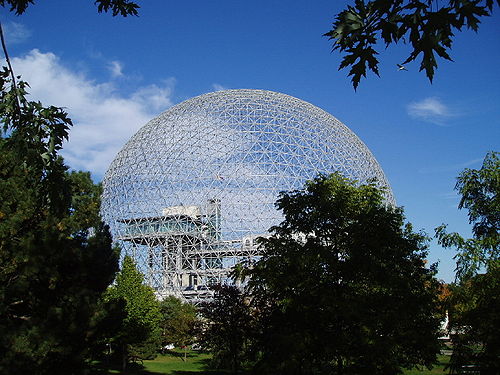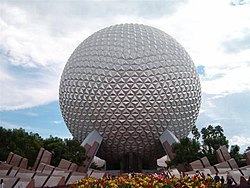Geodesic dome

A geodesic dome is a structure shaped like the top half of a sphere, made of many little shapes, usually triangles. It often is made of glass, concrete, or steel. They are cheap to make, and bigger than square buildings.
The first geodesic dome was designed after World War I by Walther Bauersfeld,[1] chief engineer of the Carl Zeiss optical company, for a planetarium to house his planetarium projector. An initial, small dome was patented and constructed by the firm of Dykerhoff and Wydmann on the roof of the Zeiss plant in Jena, Germany. A larger dome, called "The Wonder of Jena", opened to the public in July 1926.[2]
Later, they were promoted by the American engineer, Buckminster Fuller. He coined the term "geodesic". Many kits are available.
A variation on geodesic domes are monolithic domes [3]
Geodesic Dome Media
The Climatron greenhouse at Missouri Botanical Garden, built in 1960 and designed by Thomas C. Howard of Synergetics, Inc., inspired the domes in the science fiction movie Silent Running.
Science World in Vancouver, built for Expo 86, and inspired by Buckminster Fuller's Geodesic dome.
RISE, public art designed by Wolfgang Buttress, located in Belfast, consists of two spheres which utilise Buckminster Fuller's Geodesic dome.
Buckminster Fuller's own home, undergoing restoration after deterioration.
References
- ↑ First Geodesic Dome: Planetarium in Jena 1922 incl. patent information Archived March 19, 2013, at the Wayback Machine
- ↑ "Zeiss-Planetarium Jena: Geschichte". Planetarium-jena.de. Archived from the original on 2015-08-31. Retrieved 2015-08-30.
- ↑ Jonathan Glancey. "The story of Buckminster Fuller's radical geodesic dome". Retrieved 2017-11-10.





